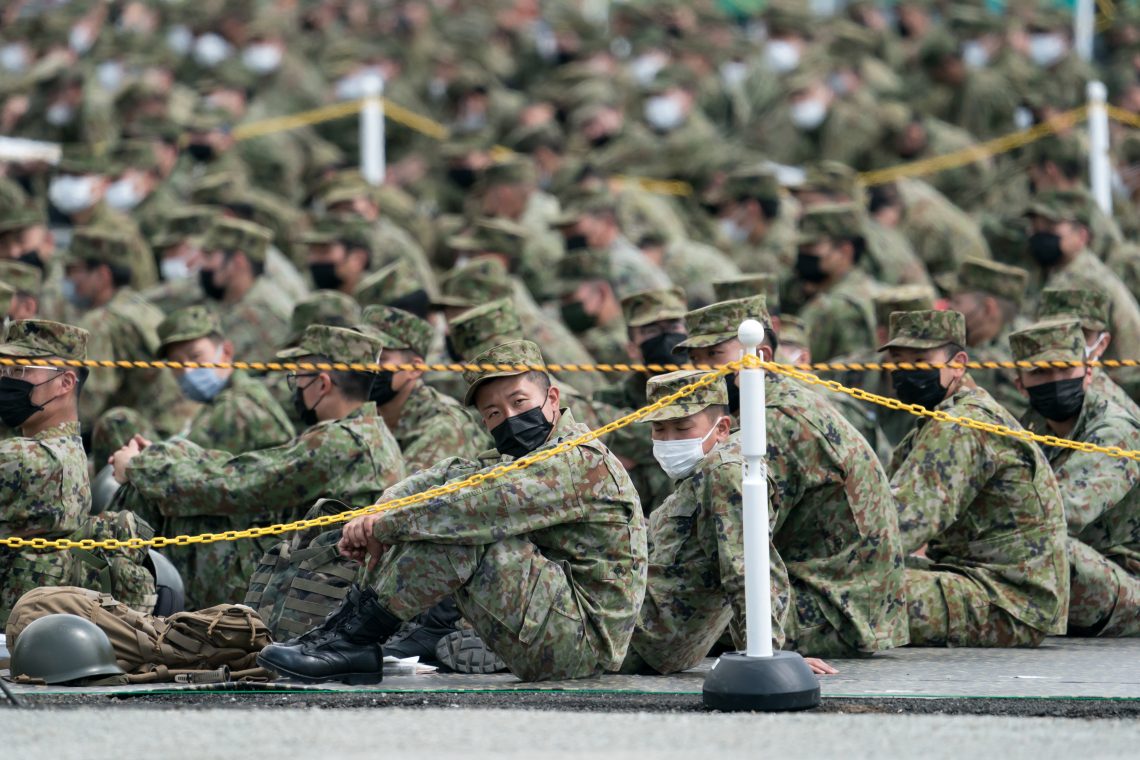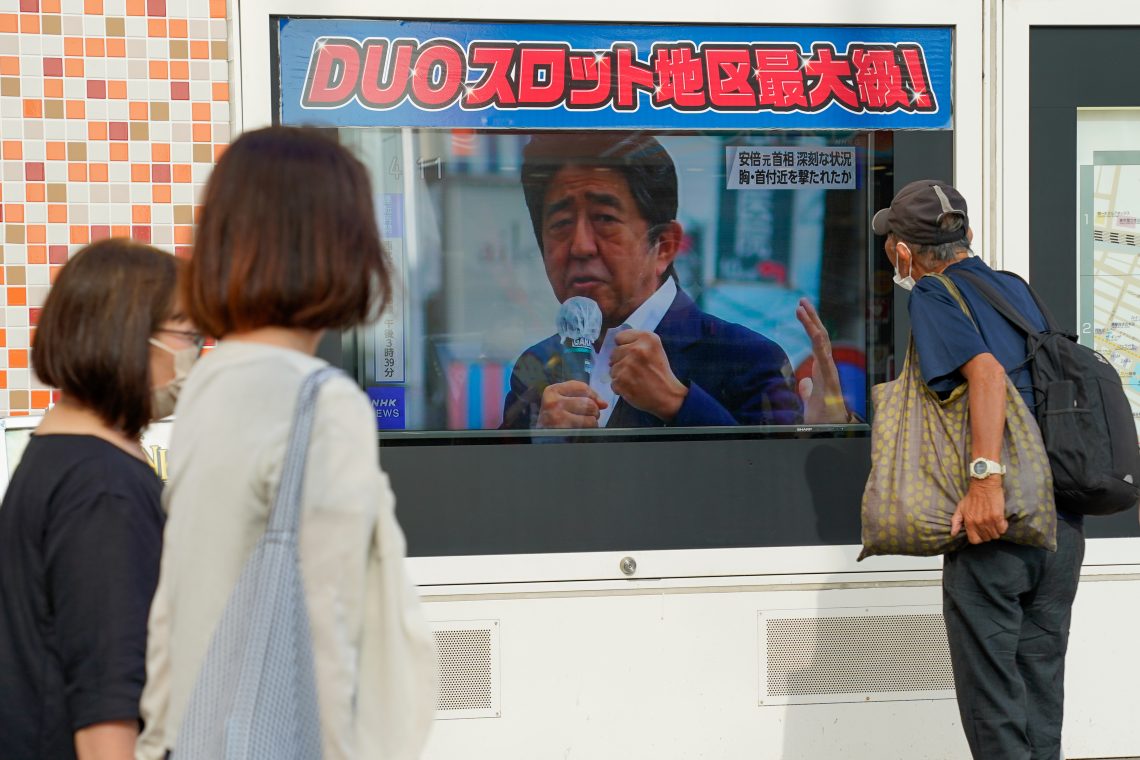Multitasking for Japan’s strategists
Evolving alliances and an assertive China will press Tokyo to embrace a more dynamic security policy.

In a nutshell
- Japan faces shifting security challenges beyond its shores
- Fears are growing that China will act against Taiwan
- Tokyo welcomes a new U.S.-led regional economic framework
For some seven decades after the end of World War II, the principles of Japan’s security strategy seemed straightforward. Here was a country that had paid dearly for the folly of misguided imperialism: its backbone broken by the first use of nuclear weapons in war, the proud monarch on the Chrysanthemum Throne had to sue for unconditional surrender.
The American victors, under the leadership of General Douglas MacArthur, Supreme Commander for the Allied Powers, kept the emperor in his role, ensuring stability in a devastated country. And with an entirely new constitution, the United States ensured that the new Japan would have both a constitutional monarchy and a modern liberal democracy.
Farewell to pacifism
The constitution’s most significant and unusual regulation, which until today has not been amended, is Article 9: “Aspiring sincerely to an international peace based on justice and order, the Japanese people forever renounce war as a sovereign right of the nation and the threat or use of force as means of settling international disputes.”
“In order to accomplish the aim of the preceding paragraph, land, sea, and air forces, as well as other war potential, will never be maintained,” the article continues. “The right of belligerency of the state will not be recognized.”
Of course, the pacifism of these noble words was never fully implemented in Japan’s political reality. Tokyo maintains a respectable array of military weapons and self-defense forces numbering some 250,000 personnel. A few years after the constitution’s May 1947 enactment, when the Korean War broke out, the U.S. itself urged Japan – in the eyes of MacArthur, an “unsinkable aircraft carrier” – to end its pacifism and enter into the conflict. Those who argue that Japan should abandon its course of overseas military restraint maintain that Japan is simply too powerful to play a role akin to neutral Switzerland.
During the Persian Gulf War of 1990-1991, Japan insisted on not sending military forces. Instead, its contribution to the U.S.-led coalition came from billions of dollars in war financing. During the Iraq War (2003-2011), Japan provided logistical and medical assistance and, as a result, got a better deal. And more recently, with China reasserting its hegemonic aspirations, Tokyo had to realize that times have changed; there is no longer space for a position of pacifist withdrawal.
America’s reliability
It was U.S. President Donald Trump who got things moving. After a long period with a posture more accommodating to China, Washington changed course, declaring Beijing the main threat to American interests. While avoiding the blunt talk of his predecessor, President Joe Biden has so far pursued the same tough approach toward China as the Trump administration.
Tokyo has welcomed this continuity. Japan is of the same view as Washington that Beijing, together with other autocracies, is leading a dangerous and determined attack on the free world.
With his erratic foreign and security policy approach, Mr. Trump created great upheaval in East Asia. Concern spread even among the most valued American allies about the reliability of the U.S. security umbrella. President Trump’s frequent complaints demanding greater contributions to their common security raised the question of whether Washington would provide unconditional protection in a case of acute crisis.
U.S. President Biden has so far pursued the same tough approach toward China as the Trump administration.
In Japan, doubts emerged whether the U.S. would support its forces in defending the Senkaku Islands in the East China Sea, which are under dispute with China. Japan was also concerned about Mr. Trump’s approach to North Korea, where the freewheeling U.S. leader acted entirely independently – without consulting Seoul or Tokyo, even though both have existential security interests at stake.
President Biden’s landmark visit to Tokyo in May 2022 reinforced the reliability of the U.S. as Japan’s most important ally. Japanese Prime Minister Fumio Kishida, who hosted the summit of the Quadrilateral Security Dialogue (also known as the Quad), had successful bilateral meetings with Mr. Biden. Japan was glad to hear the president’s promise of “deterrence backed by the full range of U.S. conventional and nuclear defense capabilities.”
Japan also noted with satisfaction that Mr. Biden chose the Tokyo summit to launch a new regional initiative to contain the economic and geopolitical influence of an increasingly assertive China. The Indo-Pacific Economic Framework for Prosperity (IPEF) – which brings together 13 countries representing some 40 percent of global gross domestic product (GDP) – is still in its infancy and cannot be compared to the Trans-Pacific Partnership (TPP), which President Trump had handicapped. But for Tokyo, it is most certainly a welcome step in the right direction.
Challenges to security policy
In retrospect, the Cold War looks like a period of relative safe comfort and manageable complexity. Japan effectively “outsourced” its military responsibility to the Americans, paid for defense provided by Washington, and hosted a number of strategically valuable U.S. military bases – and it continues to do so.
Tokyo left much of the bigger picture – from global responsibility to protect freedom of the seas or containing international conflicts – to the U.S. Where possible and desirable, Japan would play its role as one of the world’s most important economic actors. But, even more than Germany, Japan would avoid using military muscle to back up its economic interests.
China’s rise and the war in Ukraine have made the Japanese more aware of security concerns.
Recently, this has changed drastically. Talk of the “end of history” with the Cold War’s conclusion has dissipated, and history has come back with a vengeance. Conventional wars over disputed territories with ferocious battles, thought relegated to the bloody history of the 19th and 20th centuries, have returned with full force.
When President Biden, Indian Prime Minister Narendra Modi and newly elected Australian Prime Minister Anthony Albanese joined Fumio Kishida for the Quad summit in late May, the Japanese media focused on the pall cast over the event by the war in Ukraine.
Japan has a long-standing dispute with Russia over the Kuril Islands, northeast of Hokkaido, which had been transferred to the Soviet Union after Japan’s defeat in World War II. In fact, because of this dispute, Japan still has no peace treaty with Russia. Since the recent invasion of Ukraine, there have been several Russian provocations in the Far East, among them joint Chinese-Russian air force exercises.
But Ukraine looms over the Far East also because of acute concerns about war in the Taiwan Strait. Observers fear that Chinese President Xi Jinping may learn from the military and diplomatic developments in Eastern Europe and conclude that the moment for a forceful reunification of Taiwan with the mainland has arrived.

President Xi and the Chinese leadership will also carefully watch the Biden administration’s actions; any sign of weakness may induce action from Beijing. Japan sees Taiwan as a first line of defense, and has vital interests in keeping the Taiwan Strait open. From its point of view, President Biden’s repeated affirmation that the U.S. military would help in case of a Chinese attack is welcome news. However, there are justifiable doubts about whether such decisive aid will truly come. Is Washington willing to accept mass casualties from Chinese ballistic missiles fired in retaliation for American support to Taiwan?
One of the significant legacies of Japan’s longest-serving prime minister, the late Shinzo Abe, who enjoyed particularly good relations with President Trump, is broadening the country’s international profile. He worked vigorously to strengthen Japan’s security and campaigned to abolish Article 9 of the Japanese constitution. He did not succeed but helped to increase the security consciousness of the Japanese public, and his former protege Mr. Kishida is set to advance the same effort.
Of course, China’s rise and the war in Ukraine have made the Japanese more aware of security concerns. This helps explain the fact that a majority of the Japanese in general and most members of both the ruling parties and the opposition support an increase in defense spending to 2 percent of GDP. Notably, the government plans to update its National Security Strategy by the end of the current year. In preparation for that, the ruling Liberal Democratic Party (LDP) has submitted a proposal for developing the ability to attack missile launching sites in enemy territory – undeniably a message addressed to North Korea.
Scenarios
The main challenge for Japan’s security strategy in the years to come will be to master the art of diplomatic multitasking. Of course, the U.S. alliance remains the anchor of Japan’s national security. However, the interests of the two partners do not refer only to Japan’s near environs: mainly due to the relentless rise of China, the common security interests of the U.S. and Japan have expanded in geographic and geopolitical dimensions.
For several years, both sides have come to appreciate that Japan has security interests far from its shores and possibly security engagements in common with the U.S. One first thinks of Southeast Asia and Taiwan. However, the territorial scope of their mutual security has continuously widened.
Today, Tokyo’s security strategy reaches far beyond Southeast Asia into the Indian Ocean, through which lie supply lines that are essential for the Japanese economy. Until recently, India did not rank highly in Japan’s security policy; this changed considerably with the establishment of the Quad. Both the U.S. and Japan see India as a vital force within the strategy to contain China, and the same goes for Australia.
In policymaking, Japan has dedicated itself to economic influence and incentives to expand its status overseas, and at the same time to counter Chinese expansionism. This is the approach behind the new IPEF initiative, a project still in its early stages. Bearing in mind how many challenges face the Biden administration on the domestic and international fronts, it is unlikely that Washington will have enough time and resources to realize projects quickly.
Returning to the need for Japan to get better strategic multitasking, the IPEF is an initiative deserving special attention. It is of particular interest for a country that had in vain tried to fully revive the TPP after the U.S. withdrawal, leaving only the Comprehensive and Progressive Agreement for Trans-Pacific Partnership (CPTPP), and missing the U.S.
And Japan would have to dedicate more attention to the islands in the Pacific Ocean. Recently, the Chinese have shown great interest in an area that has been traditionally under the influence of Australia and the U.S. Recent efforts at establishing economic and security cooperation with island nations by Chinese Foreign Minister Wang Yi have not been very successful, but one must assume that the Chinese will be back soon enough.
Australia and New Zealand, already facing enough trouble in an assertive Beijing, are spread thin. It will be up to the Japanese to intensify their economic and security presence in the Pacific. Bearing in mind their history during the first half of the 20th century, the strategic importance of this manner of multitasking may not come as a surprise.








